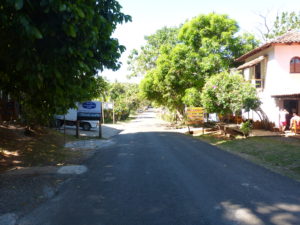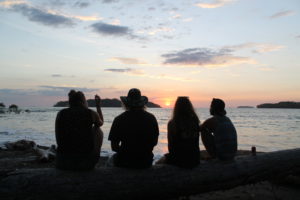Santa Catalina, Panama – A little ‘know-how’ from paradise
If you’d have asked me five years ago what I think to know about Panama I would have said the same as two months ago – Panamanians speak Spanish (or at least most of them speak something that sounds quite similar to commonly known Spanish), it’s probably really warm and I’d really like to visit it someday. Two months ago it seemed as likely for me to travel to Antarctica as to live in Santa Catalina – but here I am, establishing my life in this idyllic and authentic little fisher village in the southwest of Panama.
I’m a German expat (the latter by heart) and fluent in English, but until my plans to be a part of Panama Dive Center in Santa Catalina took shape my Spanish skills were limited to ‘vamos a la playa’, tequila and the main chorus of ‘La Cucaracha’. With the endless help of my lovely coworkers and my close friend Rosetta Stone (editor’s note: language teaching software, currently tested for Spanish, French and German in Panama Dive Center) I do plan on being able to at least have basic conversations in Spanish when I have to leave Panama in November. Until today my most said sentences definitely remain ‘Disculpe, hablo solo un poquito español’, ‘¿Cómo se dice … en español?’ and ‘una Balboa, por favor’. But to encourage all those who might be in the same situation: Don’t let missing language skills hold you back from an adventure in Central America! Everyday it feels like I’m learning twice the amount of vocabularies I already mastered, but constant progress is the most desirable kind of reward when it comes to learning a new language.
Thinking of Latin America I can’t help myself to associate every nation with a few of their traditional dishes. Whether it’s the North with Mexico’s spicy Tacos and Enchiladas, Gallo Pinot in Nicaragua or the world-famous Argentine Asado (grill). But what’s the most common food in Panama? I was sure to at least never have heard of a typical panamanian dish before. It didn’t take me long to fill this lack of information: Along the Pacific and Caribbean Coasts the usual diet consists of fresh seafood, tropical fruits and lots of root vegetables. Panamanians also have one other main common feature with the United States of America next to the shared currency: They love to deep-fry everything that might be fitting for nutritional desires. But who am I to complain, that habit provided us with Patacones, which are deep-fried discs of green plantains – a recipe that already made it in my repertory composed of only two other dishes from around the world.
One of the best and to me most surprising parts regarding the food are the various options for meat-lovers, vegetarians or even vegans – although I consider myself part of the veggie-faction most of the time I think it’s fairly easy to sustain any kind of dietary around here. Even I have days which I start off with a fresh coconut from the beach (in case you’re having difficulties figuring out how to open them yourself: our Divemaster Trainee Rodrigo can be of great help to establish those kind of life saving skills), stuff myself with an absolute unreasonable amount of melon slices, help myself with some banana and pineapple pieces from the local food truck over the afternoon and enjoy some cooled mangosteens with an even colder fruit juice in the evening – as for me I can say eating healthy rarely was this easy!
What I appreciate most about the restaurants in Santa Catalina most definitely is the variety. You’ll have to choose from an awesome pizzeria (Jammin Hostal y Pizzeria), an argentine restaurant (Los Pibes) and a great diversity of other restaurants that even offer such exotic dishes as sushi.
Closely connected to the food section is the average price range which is not as low as one may think. While an average dinner for one including drinks can be done with about 13$, it’s the secluded location of Santa Catalina which makes it possible for a package of toothpaste to cost about 3$. Cosmetics in general are more expensive than in other countries or even Panama City. Regarding food it displays mostly in western luxuries such as cheese (about 5$ for a fist-sized piece) and milk (approximately 2$ for one liter). Cheapest accommodation ranges from around 15$ for a bed in a dormitory (Hostel Villa Vento Surf) to 20$ for a Private Room (Cabañas Las Palmeras) but can go up to 80$ per night/pP (Hotel Santa Catalina). As a tourist I predict I would spend about 30$ a day for food and accommodation, excluded special day trips such as diving, snorkelling or whale and dolphin watching. A surfboard can be rented for around 10$ per day. The most famous domestic beer is the ‘Balboa’ (which also is the name of the local currency, bound to the US$ with an exchange rate of 1:1) and usually available for 1-2$ per bottle.
So how is it to live in a touristic li ttle fishing village, where you share your everyday life with locals and passing-through tourists? I’d best describe it as my personal paradise, although there are potentially troubling facts I haven’t considered up front: Let it be the humidity which will keep you and all of your clothes, towels and bedsheets moist and damp all day long (assumed it doesn’t rain anyway. Have I mentioned that rain season lasts from around April until November with various amounts of rain per day?), the mosquitos and ants, which make it impossible to leave your lunch unattended for even a second or just the complete and utter loss for any kind of date and day-related issues (thanks to my shifts in Panama Dive Center I’m at least able to keep a rough track of time). But all those small little mischiefs stand in no relation to the love and gratitude I have towards this special place! Let it be the long evenings with good friends and a nice bottle of wine, the sunsets on the beach, the first time trying to ride a wave on the beaches that brought up internationally-known surf legends, the infinite richness of the local flora and fauna or the breathtaking ‘other world’ that hides away right under the surface in Coiba National Park. With its about 400 residents Santa Catalina really is a village and if you plan on staying for longer it won’t take you long to get a grip of the vibe. Everyday someone else takes over the task of filling your day with passionate, spanish music from around midday to long after the sun set, you’ll see more and more familiar faces throughout your daily routine, most of more than happy to integrate you into the community and you’ll start to realise which are the best and cheapest fruit trucks.
ttle fishing village, where you share your everyday life with locals and passing-through tourists? I’d best describe it as my personal paradise, although there are potentially troubling facts I haven’t considered up front: Let it be the humidity which will keep you and all of your clothes, towels and bedsheets moist and damp all day long (assumed it doesn’t rain anyway. Have I mentioned that rain season lasts from around April until November with various amounts of rain per day?), the mosquitos and ants, which make it impossible to leave your lunch unattended for even a second or just the complete and utter loss for any kind of date and day-related issues (thanks to my shifts in Panama Dive Center I’m at least able to keep a rough track of time). But all those small little mischiefs stand in no relation to the love and gratitude I have towards this special place! Let it be the long evenings with good friends and a nice bottle of wine, the sunsets on the beach, the first time trying to ride a wave on the beaches that brought up internationally-known surf legends, the infinite richness of the local flora and fauna or the breathtaking ‘other world’ that hides away right under the surface in Coiba National Park. With its about 400 residents Santa Catalina really is a village and if you plan on staying for longer it won’t take you long to get a grip of the vibe. Everyday someone else takes over the task of filling your day with passionate, spanish music from around midday to long after the sun set, you’ll see more and more familiar faces throughout your daily routine, most of more than happy to integrate you into the community and you’ll start to realise which are the best and cheapest fruit trucks.
Like mentioned before – Santa Catalina is a potential paradise. Whether it will be for you depends on your personal principles and values but the foundation the setting itself offers is a fairly fascinating one and there is no other way of knowing as to try involve and engage in the laid-back and relaxed lifestyle in an environment where others are usually restricted to a few days of their yearly paid-leave.
-By Nina Berti

